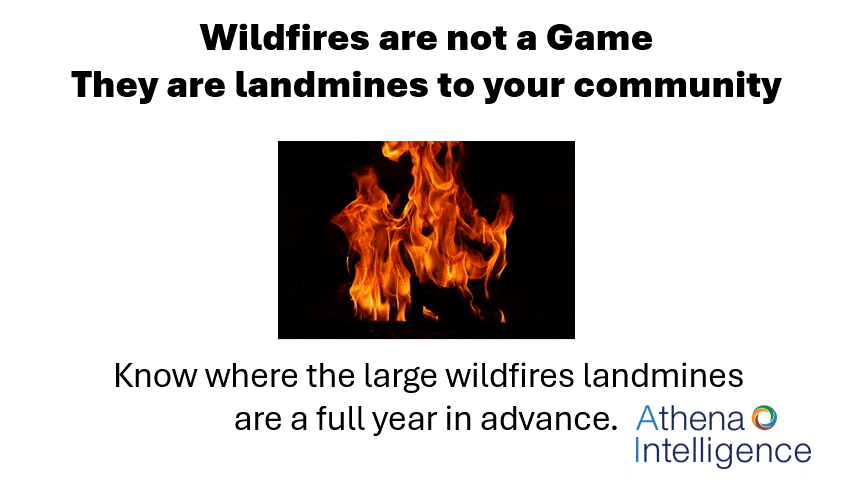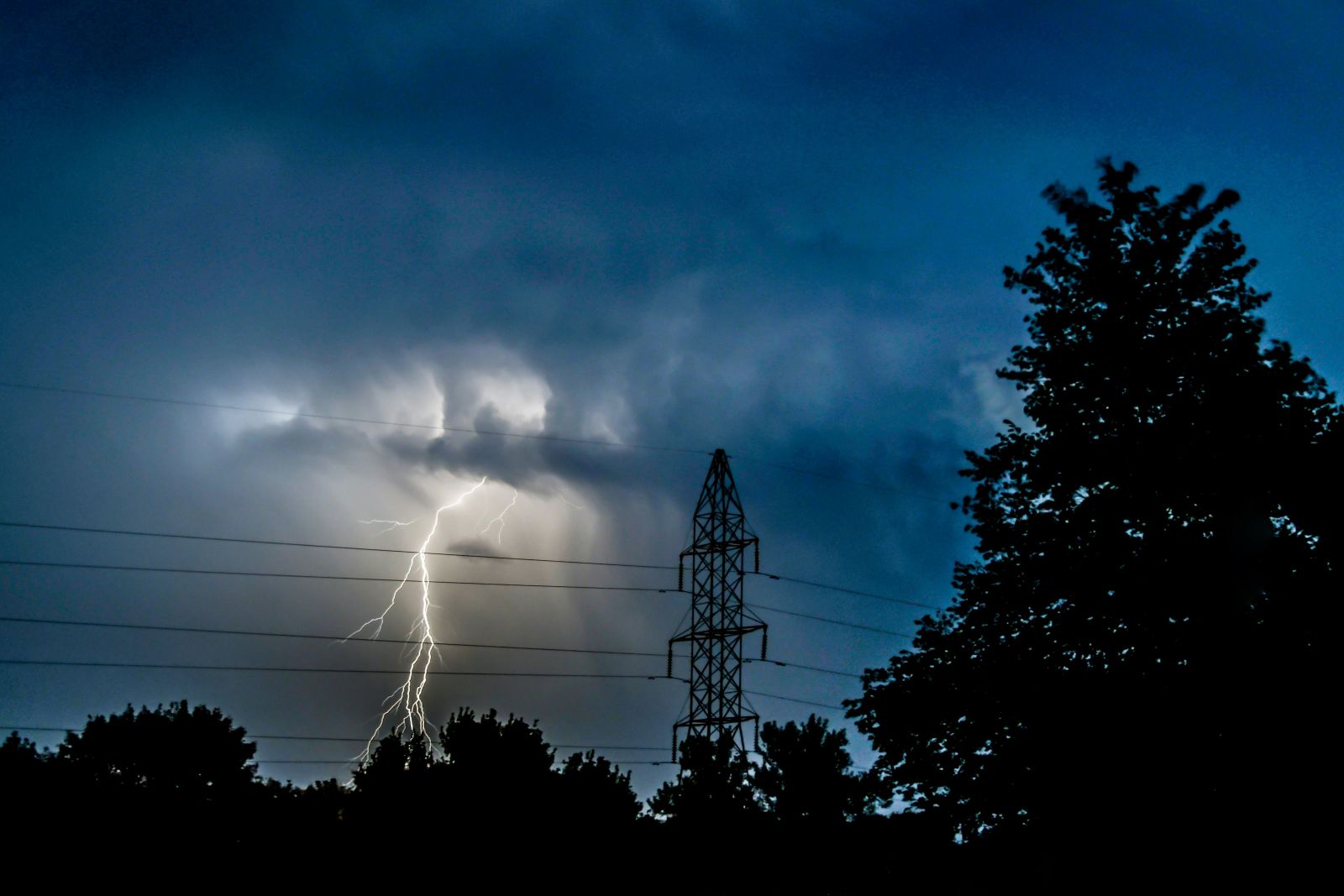Inspired by a challenge, by an Investor Owned Utility (IOU) on Innovation Works, a platform for utility industry innovation. (InnovationWorks InnovationForce.io)
Across the Western U.S., utilities are working hard to modernize aging infrastructure, especially in wildfire-prone areas. One critical need is replacing legacy equipment with modern, wildfire risk reducing equipment of various types to adapt faster to real-time conditions, improves grid reliability, and supports the growing wave of distributed generation (DER).
But a key question remains: where should these upgrades happen first?
In wildfire mitigation, timing and location are everything. The challenge isn’t just hardware deployment—it’s deploying the right hardware in the right place, at the right time.
Precomputed Risk Leads to Precision Planning
Athena provides a wildfire risk intelligence platform that allows utilities to prioritize hardware upgrades—especially digital relays—based on localized wildfire risk at the substation, feeder, and span level.
Precomputed, forward-looking wildfire risk maps that cover a full 12-month horizon. These are updated quarterly, converting static data like the USFS Landfire Wildfire Hazard Potential Maps (updated every 5 or 6 years) into Athena’s dynamic, current outlook on a regular basis.
Asset-level spatial resolution, enabling precision targeting at the infrastructure level. This is a precomputed spread model, based upon the Risk to Financial Impact on a dollars per acre basis.
Not a black-box AI—Athena is transparent, fast, and built for capital planning – and every insight is traceable to the original sources. One wildfire expert likened it to an insect’s compound eye. There is lots of wildfire data available, this is the first product which pulls the raw data sources together, weighs them and converts the data into a comprehensive picture with probabilities.
Lowest-cost situational awareness on the market—because prevention should be affordable. Because the solution is precomputed, it is not “computationally heavy” or slow.
Most wildfire models focus on rapid response or post-ignition analysis. That data arrives too late to help with mitigation. Athena is focused on prevention, not reaction. The recent Los Angeles wildfires highlighted how faster response time is insufficient to prevent fires. There was a lot of information flowing from AI generated rapid risk assessment, but what was needed was the mitigation efforts in the months before the ignition event.
Let’s put wildfire risk into perspective.
The cost to prevent a wildfire is just 5 to 7 percent of the cost to fight one. A single utility-caused ignition can lead to billions of dollars in damages—and in the worst-case scenario, bankruptcy. Yet, of the 128,000 ignition events recorded across the western United States over the past five years, only about 7,800 evolved into major wildfires.
This reveals an important truth: the real challenge isn’t simply reducing the number of ignitions—it’s understanding which ones will actually matter. Most faults don’t become fires. But when they do, the consequences can be catastrophic.
That’s why utilities must invest smarter, not just more. Athena helps identify where an ignition is most likely to lead to disaster, enabling utilities to target their protection systems and mitigation investments where they’ll make the greatest difference.
In many ways, this challenge facing all utilities is similar to the problems 40 years ago faced by American manufacturing firms and their insurers when addressing workers compensation. The problem was huge and put a number of companies into bankruptcy.
Then a new paradigm emerged: by making efforts to reduce workplace risk the cost of insurance could be moderated. Workers comp insurance is still expensive, but it is widely available (unlike a several year period in the 1980’s). Importantly, the price is tiered by industry risk and individual companies who take an active role in reducing workplace accidents can reduce their rates.
When thinking about insurance or bond ratings for utilities, wildfire risk seems likely to emerge in the same way over time.
Elsewhere here at Energy Central, a question was raised about utilities working with other agencies to prevent wildfire.
The Nature of Wildfire: It Doesn’t Respect Boundaries
One of the biggest misconceptions in wildfire planning is assuming fire behavior aligns with jurisdictional boundaries. It doesn’t.
A spark doesn’t care whether it lands on federal, state, or local land. And a fire that starts two miles away—if fueled correctly—can do far more damage than one that ignites right next to your home. What matters is how the land responds.

Athena’s model accounts for this inertial behavior of wildfires—where fuel, weather, and terrain align to create a fire that moves. It’s not about where the spark is; it’s about what happens next. That’s the critical intelligence utilities need for prevention.
The challenge of prioritizing wildfire projects was posted on a utility innovation platform which is based on the ideas of Harvard Business School’s Professor of Innovation Strategies, Linda Hill.
The utility was seeking innovation in the area of prioritizing relay upgrades in wildfire zones through 2025 and 2026. Integrating microprocessor-based relays with centralized SCADA and automation platforms will significantly improve system response and resilience. Athena’s solution is available for all utilities to consider when they visit the InnovationForce.io online platform.
By integrating Athena’s wildfire risk intelligence into their roadmap, this utility can:
-
Sequence upgrades to maximize wildfire prevention
-
Justify investments with defensible, data-backed risk metrics
-
Align hardware capabilities with actual fire weather and vegetation profiles
-
Prepare for evolving regulatory mandates with foresight. Athena’s Risk to Financial Impact is used by multiple multinational engineering and consulting firms, who are producing reports for their utility clients.
Athena’s solution doesn’t require new grants, development, pilot programs, or high-performance computing environments. Because our risk model is precomputed and already operational, it can be deployed immediately in over a dozen states, without new R&D cycles or hardware investments. (The remaining states take 2 or 3 days to bring online – immediately means 5 minutes or less.)
Wildfire data is also available to consultants involved with grant applications, regulatory reporting, rating agency cost-benefit justifications as well as engineering firms and general management consulting firms.
Smarter Upgrades. Safer Outcomes.
Wildfire mitigation isn’t about doing more. It’s about doing better—with the same tools, more strategically. We encourage you to visit Innovation Force’s platform or reach out directly to Athena.








